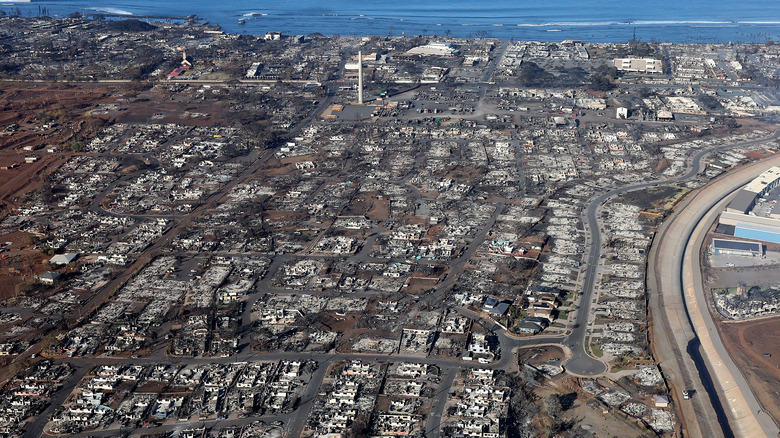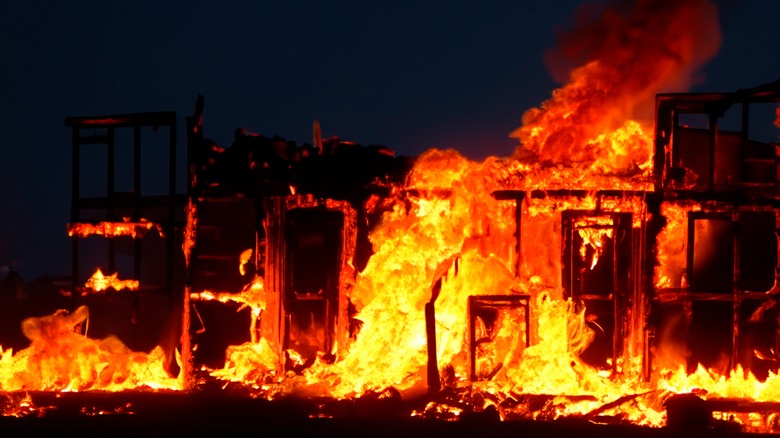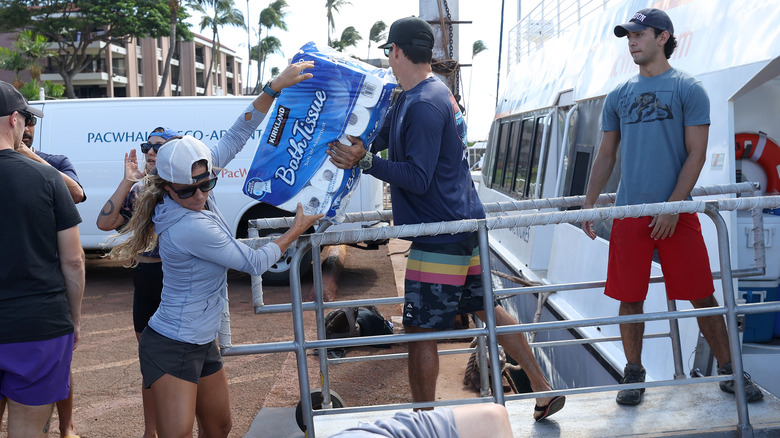The Maui Wildfires Just Made History With This Grim Statistic
On the heels of recent, uncontrollable wildfires on the island of Maui, aerial shots of its capital Lahaina depict the utter destruction and ruin of the city's once-beautiful, historic downtown. On NPR's Morning Editon, Lieutenant Governor of Hawaii Sylvia Luke said without exaggeration, "It just looked like the whole town went and dissolved into ashes." Thousands were evacuated over the course of days as winds from Hurricane Dora drove the wildfires over 2,200 homes, schools, businesses, and more. The Guardian shows a blow-by-blow of how quickly the flames ate through Hawaii's former capital city, devouring the historic Baldwin Home Museum, Maui's first Christian church Waiola Church, the Hongwanji Shin Buddhist temple, and burning the island's cherished 150-year-old banyan tree. And now we can add another horrific number to the mix: 96 dead.
That number — 96 — is the most current at the time of this writing and is a figure that will likely continue to rise. The Guardian says that hundreds still remain missing, which could cause the death toll to skyrocket. That number represents the highest amount of people killed in a U.S. wildfire in over 100 years and makes the Maui wildfires the worst in Hawaiian state history, per CBS News. Now, after the fact, not only do the residents of Lahaina need to confront the devastation that's consumed their lives and homes, they need to contend with toxic gases in the air, undrinkable and contaminated water, a massive hit to the region's economy and tourism, and much, much more.
An unprecedented, shocking disaster
A wildfire map of Maui via The Guardian shows us exactly how unlucky Lahaina got. Fires struck the center of town directly, raging along a once colorful and quaint, walkable district favored by locals and tourists alike. On NPR, Hawaiian Governor Josh Green called it the "greatest emergency we've seen in decades," while officials said it will take years to recover. Local Napua Greig asked for upcoming visitors to Maui to be mindful of the island's loss, continuing, "We have so many of our community out there just doing all they can because Maui is just really one big family," and, "They're really doing all they can to recover everyone and just do the best we can to make sure the least lives are lost in all of this."
While 96 dead is no small number, other numbers can help put the figure into perspective. In 2022, a mindboggling 7,477 wildfires tore across California, destroying nearly 900 structures and gobbling up over 330,000 acres, per CAL FIRE. But, thanks to a combination of responsiveness amongst authorities and familiarity among Californians with annual wildfires, those fires amounted to nine deaths out of a state of about 40 million people, according to the U.S. Census. Per Hawaii Demographics, Lahaina is a town of a mere 13,000 residents. If the number of dead rises even only to 130, that means that 1 out of every 1,000 people in Lahaina died as a consequence of its wildfire disaster.
Cleaning up the ashes
On August 10, President Joe Biden approved a Hawaii Disaster Declaration that makes federal aid available to Hawaiian state and local governments and related NPO recovery organizations. As The White House website says, this helps cover home repairs and temporary housing for affected residents, assistance for impacted business owners, money for debris-removal efforts, maintenance of essential services, and funds to help with emergency planning efforts. Those affected by the disaster can go to Disaster Assistance.gov and apply for aid.
While many are rightly focused on tending to the immediate needs of residents of Lahaina and grieving for the town's dead, others ask what factors might have contributed to the unprecedented havoc wrought by the wildfires. As The Washington Post describes, a "compound disaster" led to the voraciousness of the wildfire, but climate change is an obvious culprit when assessing the extent and swiftness of the wildfires' damage — even if its impact is hard to directly assess in relationship to specifics of flame ignition, propagation, intensity, spread patterns, and so forth.
Honolulu-based news outlet KITV, meanwhile, interviewed residents such as Michael Kapoustin, who described the local emergency response as "sporadic," and said that the government "could have done better" when informing locals of the extent of the disaster. CBS News also says that none of Maui's sirens turned on when the fires started on Sunday. To this Hawaii Senator Mazie Hirono said, "I'm not going to make any excuses for this tragedy," and that the state attorney general has started an investigation into the matter.


